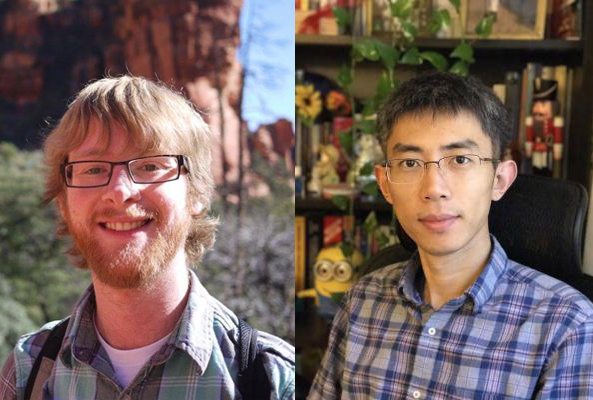
Promising Beginnings
In recognition of their promising early-career achievements, UC Santa Barbara mathematician Xin Zhou and neuroscientist Thomas Sprague have received fellowships from the Alfred P. Sloan Foundation. Each year the foundation selects fellows from a diverse group of researchers nominated by their peers.
The mathematics department is delighted to hear of Zhou’s fellowship. “Xin has already solved several significant problems about minimal surfaces and general relativity,” said department chair Jon McCammond, “and the ideas and tools he has created show great promise for future applications and developments.”
“I am very glad and honored to be selected as a Sloan fellow,” said Xin Zhou, an assistant professor of mathematics. “This is a very prestigious award for young researchers.” He said he hopes the honor will draw more attention to his field of research, especially from graduate students.
Zhou investigates the geometric properties of surfaces. He’s worked on topics with applications from the boundaries of black holes to the behavior of soap bubbles. “I started with general relativity when I entered graduate school,” he said. “I was trying to understand the relationship between different conserved quantities in a spacetime system, such as mass, energy, linear momentum and angular momentum.
“Gradually, I shifted my research focus to more pure math problems pertaining to surfaces like those that describe black holes,” Zhou added. He currently focuses on the mathematical models for soap bubbles, which involve interesting differential geometry that also applies to black holes.
Ideally, when we blow a soap bubble the volume inside doesn’t change, Zhou explained, and the surface tension of the soap will try to create an enclosure with the least amount of surface area. This shapes a typical soap bubble into a sphere, a shape that has the same curvature everywhere on its surface. Mathematicians call these “surfaces of constant mean curvature,” he said, and they model a class of black hole boundaries in general relativity.
In a flat space these surfaces are always spheres. However, general relativity tells us that the space we live in is not always flat: Matter curves it like a bowling ball on a trampoline. Zhou aims to construct these surfaces in curved spaces and investigate their properties.
Meanwhile, Thomas Sprague joined the psychological and brain sciences faculty as an assistant professor in January. “This is a very well-deserved honor for Tommy, and we are so excited to have him,” said department chair Mike Miller. “At such an early stage of his career, Tommy has already become internationally recognized for his work on how activity from neural populations in the human brain code information about the environment and guide behavior.”
“I’m very excited and honored, grateful that the foundation sees potential in my research,” Sprague said of the award, which comes with a sizable grant. “Those resources will help get the lab running in exciting new directions that wouldn’t have been possible otherwise.”
Sprague has made a name for himself investigating the way in which the brain represents information, and how it changes depending on the situation. For instance, we often encounter the same scene — say, the inside of the refrigerator — with different behavioral goals, like pouring a glass of water or finding a piece of cake. The image is the same, but the goals are different, so the way the brain encodes the information changes to correspond with the context, Sprague explained.
Rather than looking at where brain activity occurs during different tasks, Sprague focuses on understanding how activity patterns in specific regions of the brain compare under different contexts. Many of his experiments involve reconstructing what an individual remembers from a given task solely by looking at their brain activity.
“I am recovering a private, subjective experience,” he said. “This is an internal representation that’s not on the retina right now. The 10 seconds that elapse between seeing the stimulus and responding to it means that the subject has to hold this representation in their mind’s eye, and that’s what I’m trying to decode and recover.”
“Sloan Research Fellows are the best young scientists working today,” said Adam F. Falk, president of the Alfred P. Sloan Foundation. “Sloan Fellows stand out for their creativity, for their hard work, for the importance of the issues they tackle and the energy and innovation with which they tackle them. To be a Sloan Fellow is to be in the vanguard of twenty-first century science.”



